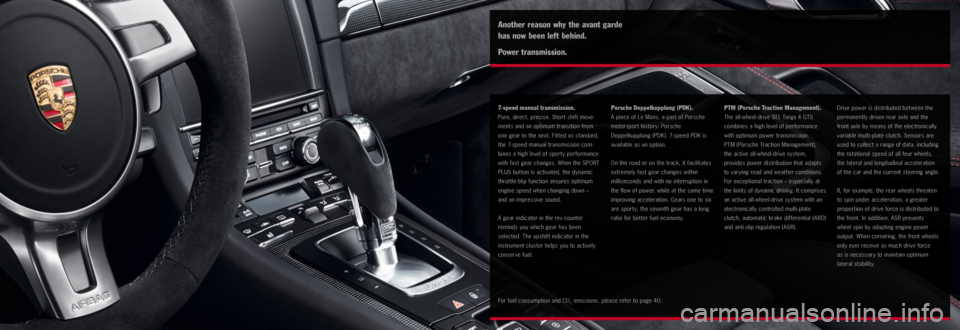automatic transmission PORSCHE 911 TARGA4 2014 6.G Information Manual
[x] Cancel search | Manufacturer: PORSCHE, Model Year: 2014, Model line: 911 TARGA4, Model: PORSCHE 911 TARGA4 2014 6.GPages: 23, PDF Size: 4.66 MB
Page 13 of 23

25
Another reason why the avant garde
has now been left behind.
Power transmission.
7-speed manual transmission.
Pure, direct, precise. Short shift move -
ments and an optimum transition from
one gear to the next. Fit ted as standard,
the 7-speed manual transmission com -
bines a high level of sport y performance
with fast gear changes. When the SPORT
PLUS but ton is activated, the dynamic
throttle-blip function ensures optimum
engine speed when changing down –
and an impressive sound.
A gear indicator in the rev counter
reminds you which gear has been
selected. The upshift indicator in the
instrument cluster helps you to actively
conserve fuel.
Porsche Doppelkupplung (PDK).
A piece of Le Mans, a part of Porsche
motorsport history: Porsche
Doppelkupplung (PDK). 7-speed PDK is
available as an option.
On the road or on the track, it facilitates
extremely fast gear changes within
milliseconds and with no interrup tion in
the flow of power, while at the same time
improving acceleration. Gears one to six
are sport y; the seventh gear has a long
ratio for bet ter fuel economy.
PTM (Porsche Traction Management).
The all-wheel-drive 911 Targa 4 GTS
combines a high level of performance
with optimum power transmission.
PTM (Porsche Traction Management),
the active all-wheel-drive system,
provides power distribution that adapts
to varying road and weather conditions.
For exceptional traction – especially at
the limits of dynamic driving. It comprises
an active all-wheel- drive system with an
electronically controlled multi-plate
clutch, automatic brake differential (ABD)
and anti-slip regulation (ASR). Drive power is distributed bet ween the
permanently driven rear axle and the
front axle by means of the electronically
variable multi-plate clutch. Sensors are
used to collect a range of data, including
the rotational speed of all four wheels,
the lateral and longitudinal acceleration
of the car and the current steering angle.
If, for example, the rear wheels threaten
to spin under acceleration, a greater
proportion of drive force is distributed to
the front. In addition, ASR prevents
wheel spin by adapting engine power
output. When cornering, the front wheels
only ever receive as much drive force
as is necessary to maintain optimum
lateral stability.
For fuel consumption and CO
2 emissions, please refer to page 40.